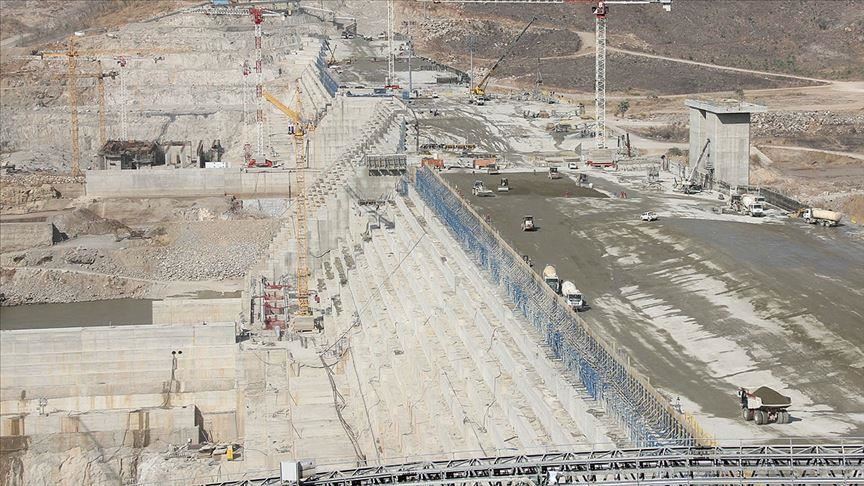Sudan and Ethiopia have issued a joint statement at the end of a one-day visit to Khartoum by the Ethiopian Prime Minister, Abiy Ahmed in which he held lengthy talks with Sudanese Prime Minister Abdallah Hamdok and also met with the head of the Sovereign Council, Lt Gen Abdelfattah El Burhan.

The statement said the visit by Ethiopia’s prime minister comes within the framework of “the continuous consultations between the leaderships of Sudan and Ethiopia, underpinned by the age-old relationship between the two sisterly countries.”
The high-level Ethiopian delegation that accompanied Abiy included Ministers of Defence, Foreign Affairs, and Water, Irrigation and Energy, in addition of a number of senior officials.
The statement said the talks between the two sides dwelt on ways of strengthening, expanding, and deepening bilateral cooperation in all fields were thoroughly discussed.
The two sides “expressed shared conviction that, given the historical, cultural, social and economic ties between the two brotherly peoples, embarking on regional integration is the way forward to fulfil their peoples’ aspirations in peace, development and pan -Africans unity.”
It said the two sides agreed to reactivate all existing bilateral mechanisms, designed to further the cooperation in different areas.
“Cognizant of their roles as major pillars of stability and peace in the Horn of Africa, both sides noticed with great satisfaction the positive, peaceful and more harmonious atmosphere, which is currently prevailing in the Horn, and pledged to redouble their efforts to consolidate and nurture these gains,” it said
On the question of the Grand Ethiopian Renaissance Dam (GERD), both sides emphasised the “imperative of exerting every possible effort to attain a successful conclusion of the ongoing trilateral negotiations under the auspices of the AU leading to a win-win formula that would make the GERD a vehicle for regional integration between the riparian countries”
Both Sudan and Ethiopia expressed their support and commitment to the AU-led mediation in the GERD negotiations. It added that “They view this initiative as manifestation of the principle of African solutions to African problems.”
The visit programme was concluded by a meeting Abiy and Sovereign Council Chairman El Burhan.
Mega-dam
In March 2011, Ethiopia announced its plans to build a large dam at the Blue Nile, in the Benishangul-Gumuz region, about 15 to 40 km east of the border with Sudan, as a jointly funded, owned, and operated project between the three countries. Egypt and Sudan vehemently opposed the proposal. They claimed adverse effects on their Nile water rights and interests. Khartoum later softened its position.
The countries signed a Declaration of Principles in Khartoum in March 2015 as a basis for negotiations, but no breakthrough on the use of the Nile waters has been made since. Months-long talks under auspices of the US administration in Washington earlier this year failed as well.
Addis Ababa has indicated on several occasions that, even without an agreement, it will start filling the reservoir in July, while construction work continues. It needs more hydropower as only 25 per cent of the population has access to electricity. Cairo, however, has warned that Ethiopia will not be able to unilaterally fill the dam without consequences. Egypt relies on the Nile for more than 90 per cent of its water.
With the start of the rainy season, the dam is now holding backwater. Ethiopia said on Tuesday that the first phase was already achieved because of good rainfall during the rainy season in the Horn of Africa country and the dam is overflowing.
The dam, when finished in 2022, will have a reservoir with a volume of more than 74 billion cubic metres, and a capacity of 6,450 megawatts,
The Blue Nile contributes approximately 85 per cent to the volume of the main Nile River.
African Union
Kenya and peers in the Nile Basin want the AU to continue mediating in the dam as they fear external influence may derail the search for a deal.
At a meeting of the AU Bureau of Heads of States on Tuesday, President Uhuru Kenyatta said the three countries should continue working through the AU as each one’s interests will be assured.
“This process has vividly shown that ‘African solutions to African problems’ is the way to go. We can resolve our disputes through negotiations and mediation within the framework of the African Union,” the president said.
In addition to Kenya, White Nile riparian countries like Rwanda, Tanzania, and Uganda support Ethiopia’s right to build the dam.
The Nile Basin Initiative, a multilateral forum for all eleven riparian states (Egypt, Ethiopia, Sudan, Uganda, Kenya, Rwanda, Burundi, the Democratic Republic of Congo, Tanzania, South Sudan, and Eritrea) established in 1999, has been weakened because of the tensions caused by the Ethiopian dam.

